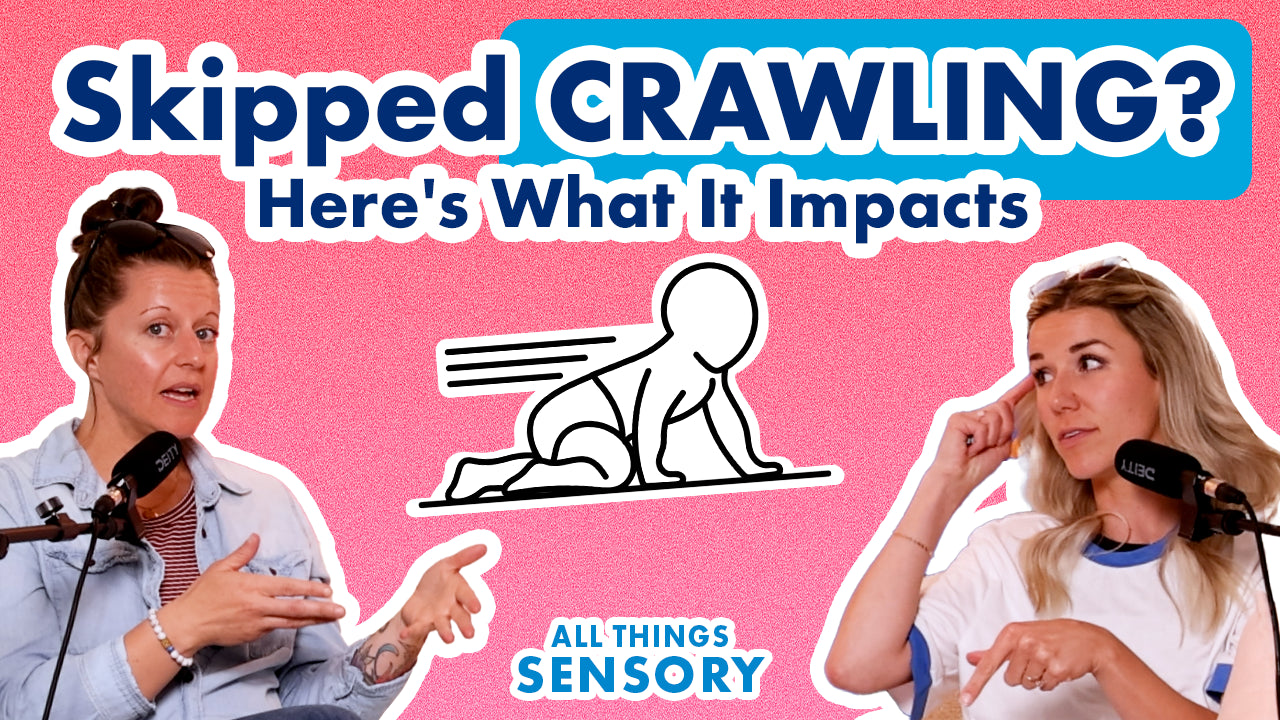Your Cart is Empty

Crawling is a foundational developmental milestone that does more than just strengthen muscles — it plays a critical role in developing the visual system, especially ocular motor skills such as tracking, convergence, and coordinated eye movements.
We’re diving into why crawling is essential and how to help children of ALL ages crawl!
Crawling for Brain Development
All Things Sensory Podcast Instagram
For many parents, crawling might seem like just another cute milestone on the way to walking. But from a developmental perspective, crawling is a critical step in the foundation of healthy brain and body development.
When babies crawl, their entire body and brain are activated in a way that sets the stage for higher-level learning and functioning. Here’s how:
Crawling uses opposite sides of the body (right arm/left leg, then left arm/right leg), which stimulates both hemispheres of the brain.
These cross-lateral movements strengthen the corpus callosum, the brain structure that helps the two sides of the brain communicate.
This coordination is a building block for reading, writing, and other academic and motor skills.
Babies must look forward while crawling, which promotes visual tracking and eye teaming (both eyes working together).
These ocular motor skills are necessary for activities like reading across a page, copying from the board, catching a ball, and even walking safely.
Crawling builds depth perception, visual scanning, and spatial awareness.
The constant head movement while crawling activates the vestibular system, which helps children understand motion, balance, and spatial orientation.
Weight-bearing through the arms and legs during crawling provides proprioceptive input that enhances body awareness and coordination.
These sensory systems help children feel grounded and oriented in space.
If a baby isn't crawling when expected, it’s rarely due to a lack of motivation. More often, it's because they don’t yet have thecore strength,coordination, orneuromotor readiness to do so.
Statements like “they’re just lazy” or “they’ll skip it and be fine” can unintentionally dismiss developmental red flags. Research and clinical experience suggest that skipping crawling or crawling for only a short period may impact later skills like handwriting, reading fluency, ball handling, and even emotional regulation.
If your baby is approaching or past 9–10 months and hasn’t started crawling on hands and knees, here are some therapist-backed strategies:
Crawling up stairs (with supervision) to naturally encourage reciprocal movement.
Rocking back and forth in hands-and-knees (quadruped) position to build confidence and disassociate upper and lower body movements.
Leg lifts while lying on their back (e.g., kicking a balloon or ball) to engage core muscles.
Crawling over pillows, bolsters, or your legs to encourage shifting weight and hip extension.
Use motivating toys just out of reach to promote reaching and crawling.
OT Tip:Try a cold tile or textured surface. Some babies avoid belly contact with cold floors, prompting them to lift their bodies and attempt crawling.
Remember: army crawling (belly crawling) is a great step, but true hands-and-knees crawling is ideal.
It’s never too late to crawl! Children—and even adults—can benefit from revisiting crawling as a sensory-motor exercise. For children who skipped crawling, have visual tracking issues, or struggle with coordination:
Introducebackward crawling, which increases challenge and coordination.
Tryvisual-motor activities while crawling, such as reading a chart, following a line, or navigating an obstacle course.
Make it fun with games, tunnels, or family crawling races!
While army crawling shows emerging mobility, it lacks the full-body integration of hands-and-knees crawling. It may indicate a need to further develop:
Core strength.
Reflex integration (especially the STNR).
Upper and lower body coordination.
Ocular motor and vestibular function.
If your child only army crawled or crawled for a very short time, incorporating crawling games and exercises into daily play can help.
Encouraging crawling sets the stage for lifelong skills, including:
Improved attention and body awareness.
Better reading and writing mechanics.
Enhanced balance and coordination.
Visual tracking and hand-eye coordination.
Emotional regulation and confidence.
From infancy to early childhood—and even beyond—crawling is a foundation, not a footnote.
BORING, BUT NECESSARY LEGAL DISCLAIMERS
While we make every effort to share correct information, we are still learning. We will double check all of our facts but realize that medicine is a constantly changing science and art. One doctor / therapist may have a different way of doing things from another. We are simply presenting our views and opinions on how to address common sensory challenges, health related difficulties and what we have found to be beneficial that will be as evidenced based as possible. By listening to this podcast, you agree not to use this podcast as medical advice to treat any medical condition in either yourself or your children. Consult your child’s pediatrician/ therapist for any medical issues that he or she may be having. This entire disclaimer also applies to any guests or contributors to the podcast. Under no circumstances shall Rachel Harrington, Harkla, Jessica Hill, or any guests or contributors to the podcast, as well as any employees, associates, or affiliates of Harkla, be responsible for damages arising from use of the podcast.
Keep in mind that we may receive commissions when you click our links and make purchases. However, this does not impact our reviews and comparisons. We try our best to keep things fair and balanced, in order to help you make the best choice for you.
This podcast should not be used in any legal capacity whatsoever, including but not limited to establishing “standard of care” in a legal sense or as a basis for expert witness testimony. No guarantee is given regarding the accuracy of any statements or opinions made on the podcast.
Comments will be approved before showing up.